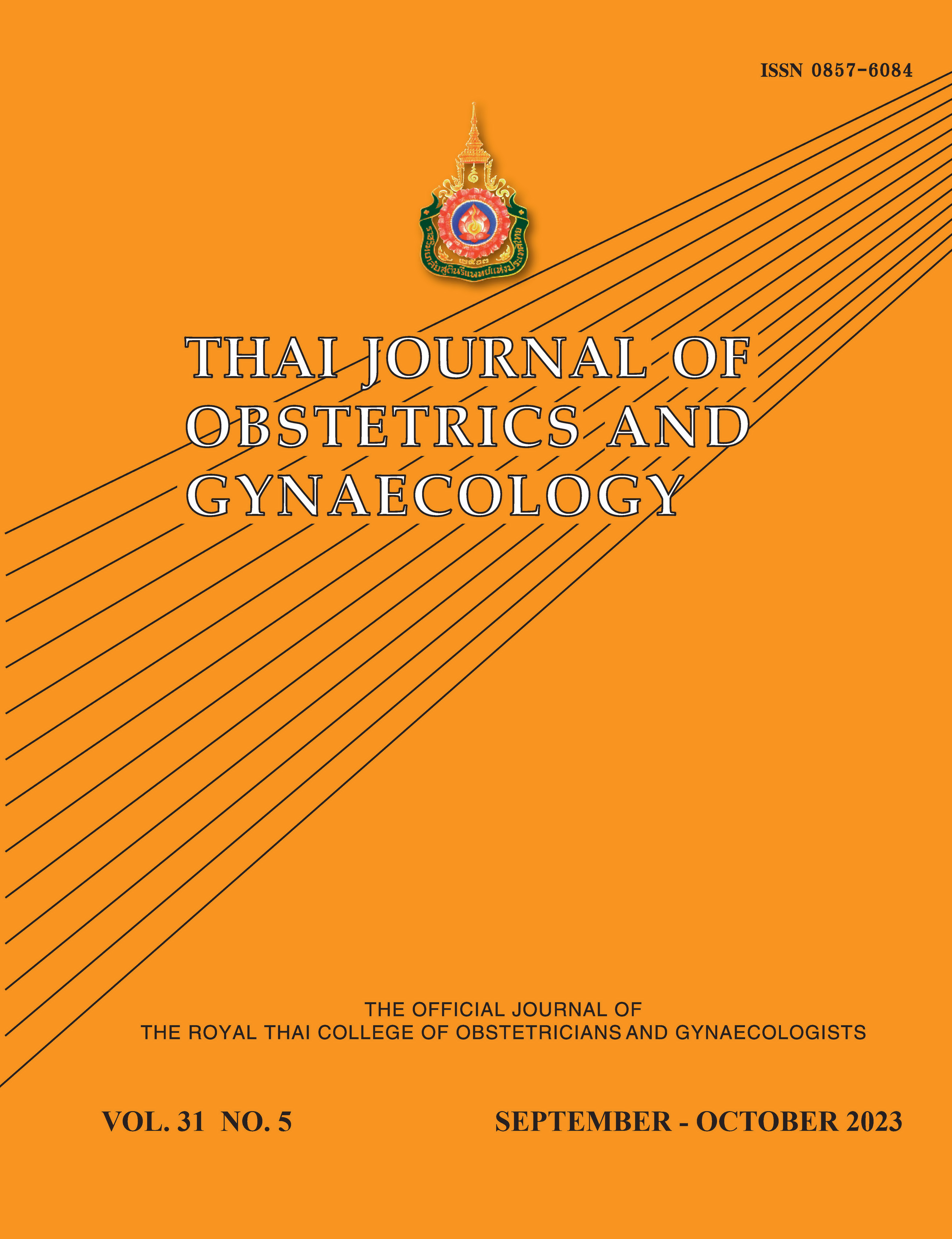Causes of Secondary Amenorrhea: A report of 437 cases in Thailand
Main Article Content
Abstract
Objectives: The aim of this study was to determine the prevalence of etiologic causes of secondary amenorrhea in Thailand.
Materials and Methods: A retrospective study was performed using 437 complete medical records of women with secondary amenorrhea who visited the Gynecologic Endocrinology clinic, Department of Obstetrics and Gynecology, Faculty of Medicine Siriraj Hospital, Mahidol University, Thailand from April 1999 to October 2020
Results: At the time of registration at our clinic, the patients had an average age of 28.7 ± 7.7 years. The median duration of amenorrhea was 8 months (range three months to 228 months). The majority of patients were nulliparous (70%). The average body mass index (BMI) was 25.2 ± 6.7 kg/m2. More than half of all patients were overweight (11.2%) and obese (42.6%). Patients with polycystic ovary syndrome (PCOS) had the highest BMI. The four most common causes of secondary amenorrhea were PCOS (30.2%), anovulation (27.2%), hyperprolactinemia (9.8%), and premature ovarian insufficiency (9.2%). Other etiologies were diverse and less frequent. Two thirds of etiologies of secondary amenorrhea were in compartment four (67.5%). The prevalence of causes of secondary amenorrhea in compartment two (9.2%) and three (10.1%) was similar. The uterine cause and outflow tract obstruction was the least common cause of secondary amenorrhea (8.0%) of all four compartments. Postpill amenorrhea was found in 6.4% of patients. Meanwhile, thyroid disorder was the cause of secondary amenorrhea in 5% of patients.
Conclusion: The most common causes of primary and secondary amenorrhea were different. The most common cause of secondary amenorrhea in this study was PCOS. Further studies are required to determine the difference in causes of secondary amenorrhea in different nations.
Article Details

This work is licensed under a Creative Commons Attribution-NonCommercial-NoDerivatives 4.0 International License.
References
Taylor HS, Pal L, Seli E. Amenorrhea. In: Taylor HS, Pal L, Seli E, editors. Speroff’s clinical gynecologic endocrinology and infertility. 9th ed. Philadelphia: Wolters Kluwer 2020;343-94.
Kwon SK, Chae HD, Lee KH, Kim SH, Kim CH, Kang BM. Causes of amenorrhea in Korea: Experience of a single large center. Clin Exp Reprod Med 2014;41: 29-32.
Rotterdam ESHRE/ASRM-Sponsored PCOS consensus workshop group. Revised 2003 consensus on diagnostic criteria and long term health risks related to polycystic ovary syndrome(PCOS). Human Reprod 2004;19:41-7.
Tanmahasamut P, Rattanachaiyanont M, Dangrat C, Indhavivadhana S, Angsuwattana S, Techatraisak K. Causes of primary amenorrhea: a report of 295 cases in Thailand. J Obstet Gynaecol Res 2012;38:297-301.
Reindollar RH, Novak M, Tho SP, McDonough PG. Adult-onset amenorrhea: a study of 262 patients. Am J Obstet Gynecol 1986;155:531-43.
Gordon CM. Clinical practice. Functional hypothalamic amenorrhea. N Engl J Med 2010;363:365-71.
Skalba P, Guz M. Hypogonadotropic hypogonadism in women. Endokrynol Pol 2011;62:560-7.
Fourman LT, Fazeli PK. Neuroendocrine causes of amenorrhea--an update. J Clin Endocrinol Metab 2015;100:812-24.
Bili H, Laven J, Imani B, Eijkemans MJ, Fauser BC. Age-related differences in features associated with polycystic ovary syndrome in normogonadotrophic oligo-amenorrhoeic infertile women of reproductive years. Eur J Endocrinol 2001;145:749-55.
Imani B, Eijkemans MJ, te Velde ER, Habbema JD, Fauser BC. A nomogram to predict the probability of live birth after clomiphene citrate induction of ovulation in normogonadotropic oligoamenorrheic infertility. Fertil Steril 2002;77:91-7.
Practice Committee of American Society for Reproductive M. Current evaluation of amenorrhea. Fertil Steril 2008;90:S219-25.
Legro RS. Polycystic ovary syndrome: the new millenium. Mol Cell Endocrinol 2001;184:87-93.
Committee opinion no. 605: Primary ovarian insufficiency in adolescents and young women. Obstet Gynecol 2014;124:193-7.
European Society for Human R, Embryology Guideline Group on POI, Webber L, Davies M, Anderson R, Bartlett J, et al. ESHRE Guideline: management of women with premature ovarian insufficiency. Hum Reprod 2016;31:926-37.
Reindollar RH, Byrd JR, McDonough PG. Delayed sexual development: a study of 252 patients. Am J Obstet Gynecol 1981;140:371-80.


